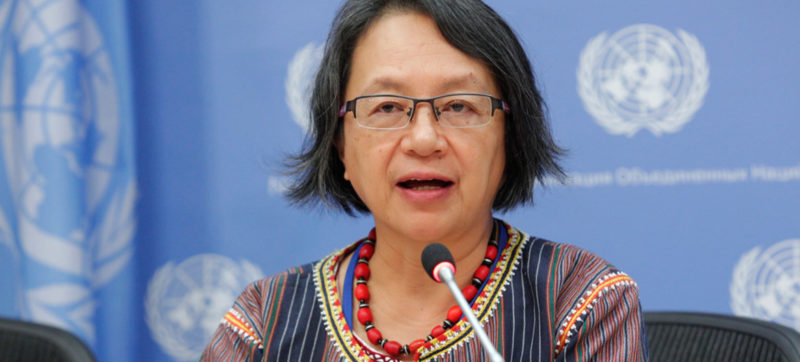New findings released on Wednesday, June 27, 2018 in Oslo suggest Indigenous Peoples and local communities dramatically outperform other managers, conserving lands and forests for a quarter the cost of public and private investments to conserve protected areas.

The new report, “Cornered by Protected Areas,” co-authored by Special Rapporteur on the Rights of Indigenous Peoples, Victoria Tauli-Corpuz, and the Rights and Resources Initiative (RRI) was released as forest researchers revealed a spike in deforestation that threatens efforts to reach global climate goals.
“If we are to save the world’s forests and prevent a climate crisis, Indigenous Peoples and local communities must be part of the solution,” Tauli-Corpuz reminded participants from government, civil society, and the scientific community at the world’s largest gathering on tropical forests and their role in achieving global climate and development goals. “Based on a growing body of evidence, they make tremendous contributions, conserving some of the most biodiverse lands on Earth.”
Separately, but also in Oslo, a new analysis from the University of Maryland on Global Forest Watch was released on Wednesday, reporting the loss of a record-high 15.8 million hectares of tropical forest cover in 2017. The findings suggest that efforts of Indigenous Peoples to conserve the world’s forests and forest carbon are more urgent than ever before, said Tauli-Corpuz.
“This conservation research underscores the cost of ignoring communities and their immense contributions to conservation,” said Alain Frechette, Director of Strategic Analysis and Global Engagement at RRI. “Investments in forest protection would be more efficient and more just if allocated to the people who have kept the forests standing up until now.”
Indigenous Peoples and local communities have customary rights to at least half of the world’s land, but legal ownership over just 10 percent. Research has shown that legally recognized indigenous and community forests store more carbon and experience lower rates of deforestation than forests under other tenure regimes – including protected areas.
Despite protecting their lands – often for generations – Indigenous Peoples and local communities are confronting a growing trend in the designation of their lands across the Global South as “protected areas,” creating a crisis of criminalisation and human rights violations, according to the findings presented today by Tauli-Corpuz.
“Instead of partnering with the people who live in and depend on forests, conservation initiatives continue to drive communities from their ancestral lands, part of a larger trend of criminalisation worldwide,” said Tauli-Corpuz. “In some cases, they are declared squatters in their own territories. In my capacity as Special Rapporteur, I have seen a disturbing uptick of harassment, criminalisation, and even extrajudicial killings targeting communities.”
The new report examined the impacts of protected areas on Indigenous People and local communities in 28 countries, and estimated the conservation investments of communities in 14 countries. It concluded that:
- Indigenous Peoples and local communities have only limited recognition of their community land rights in protected areas;
- In spite of this legal insecurity, indigenous and local communities worldwide invest up to $4.57 billion per year in conservation, including up to $1.71 billion per year in forest conservation – as much as 23 percent of the amount spent on land and forest conservation by the formal environmental community;
- Communities achieved equal or better conservation results with lower levels of investment – showing that they are not only the most effective, but also the most cost effective stewards of their lands.
In Peru, for instance, legal recognition of community forest rights reduced deforestation and disturbance by as much as 81 percent in the year following titling, and by 56 percent the year after; in other words, securing land rights can lead to immediate environmental benefits.
In Brazil, community forests store 36 percent more carbon per hectare than other forests. And given that indigenous and local community lands hold at least one quarter of the world’s aboveground tropical forest carbon – and likely much more – ensuring that communities have secure rights to these lands is critical to larger efforts to protect forests and the carbon they contain.
Governments and environmental organisations have made numerous commitments and pledged to adhere to international standards, yet the communities responsible for maintaining the world’s lands and forests face increasing threats.
The trend of “militarisation of conservation” – arming park rangers and organising them as a military unit – began as a way to help rangers defend themselves against poachers and organised terrorists, but the report notes that violence by armed rangers against unarmed Indigenous Peoples and local communities has been documented in the Central African Republic, the Democratic Republic of the Congo, Guatemala, South Africa, and elsewhere.
India’s Kaziranga National Park alone has seen 106 extrajudicial killings in the last 20 years. Elsewhere, communities face criminalisation and violence for practicing their traditional livelihoods.
The findings come as the Special Rapporteur herself faces charges of terrorism in her native Philippines by President Rodrigo Duterte’s government, which Tauli-Corpuz believes were filed in retaliation for her advocacy on behalf of displaced Indigenous Peoples in the Mindanao region of the Philippines.
“The science is clear: forests are the best tool we have to combat climate change, and to conserve our forests we need to recognise the rights of the Indigenous Peoples and local communities who invest in protecting them,” said Frechette. “Global conservation schemes such as REDD+ and the Aichi Biodiversity Targets reference the need to consult Indigenous Peoples and local communities. But this is clearly not enough. In order to fully respect the rights of the world’s Indigenous Peoples, we urgently need to move toward rights-based conservation models that can secure human well-being and global progress on climate and development priorities.”
